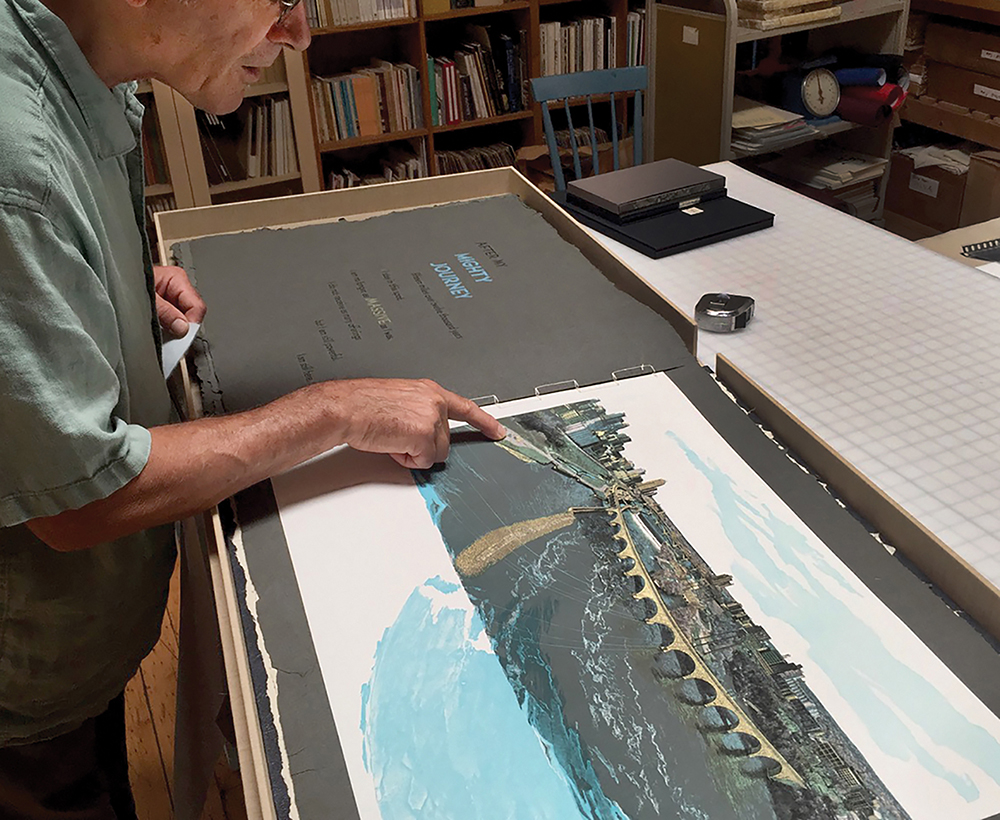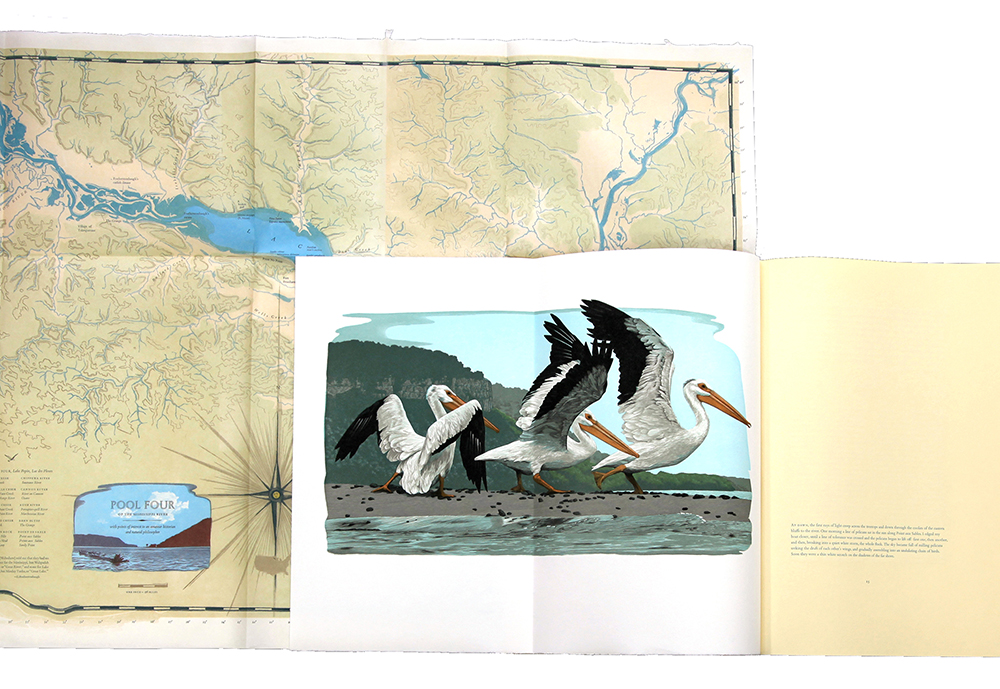
Gaylord Schanilec points out detail in his book “My Mighty Journey.” (PHOTO BY ROBERT ROWE)

ROBERT ROWE
Book arts exist in the nexus of literature and art. Schanilec studied both poetry and art in college in North Dakota where he was influenced by the work of Thomas McGrath, a leading figure in the “Spirit of Place” movement in American poetry. Spirit of Place is sometimes described as the “soul” or personality of a physical location. Bonding with and eulogizing place is distinct from “regionalism” in that it dives deeper into the specifics of a more tightly circumscribed locale and makes an almost metaphysical connection.
Perhaps best exemplifying this commitment to place, Schanilec’s book “Lac Des Pleurs” is a paean to the natural and social history of Lake Pepin, a particular expanse on the Mississippi River between Wisconsin and southern Minnesota. “Lac Des Pleurs,” meaning “Lake of Tears,” is what French explorer Louis Hennepin named the lake in the seventeenth century. Seven years in the making, this fine-press edition of 100 copies includes six large-scale wood engravings of fish, birds, and plants. The images are accompanied by excerpts of the writings of many prominent historical figures who have traveled through and commented on the area. In making “Lac Des Pleurs,” Schanilec worked with an expert on riparian biology.
The medium of wood engraving requires the artist to use fine tools to cut an image into end-grain blocks of hard maple. It seems well-suited to Schanilec’s keen observation of the natural world. By using carefully spaced lines and other marks, the artist can create prints with exceptionally fine detail. The process is long and tedious—each color requires a separate block—but it can produce images of extraordinary subtlety and beauty.
During my visit to Schanilec’s studio, I saw the finished version of one of his newer works, “My Mighty Journey,” a collaborative project with writer John Coy. Underwritten by the Minnesota Historical Society and aimed at young readers, “My Mighty Journey” tells the story of St. Anthony Falls in the Mississippi River at the Twin Cities. The book traces the Falls’ history from the ice age to the present. It recounts how people have interacted with the falls, beginning with early mammoth hunters and indigenous peoples, through the coming of lumber and flour mills, and on to the present day.
To create the 16 large-scale prints that illustrate “My Mighty Journey,” Schanilec sought assistance from an archaeologist, a planetarium director, local historians, scientists, representatives of the Native American community, artisans in papermaking and book binding, a drone photographer, and numerous interns and volunteers. To affect an even stronger connection with the spirit of the river, he enlisted a team of young volunteers to scour the riverbank for material that could be used in the printing of the images. The volunteers collected driftwood, snake skin, leaves, bricks, even dead fish. Some material, like cottonwood bark, driftwood, and limestone, were milled to the correct thickness and used to print clouds, water, and other landscape elements to complement the engravings. The effect is a series of multilayered images that convey the raw power of the falls.
“My Mighty Journey” exists in two forms, a fine press edition of 40 copies and a commercially-printed trade edition. The beautifully hand-bound fine press version is 20×26 inches, with original prints and handset type. Like Schanilec’s other fine press books, each copy commands a multi-thousand-dollar price. The University of Iowa Library’s Special Collections is one of the 25 or so institutions that have standing orders for every book he produces.
How is Gaylord Schanilec’s work relevant to Peoria? My Mighty Journey came about through a community-wide collaboration that brought together historical, cultural, artistic, literary, and scientific perspectives. It is an excellent example of how artists’ efforts can elevate awareness of, and appreciation for, the spirit of the place where we live. Peoria is also a place on a river that is strong in spirit and has many stories to tell. Peoria is also home to a wealth of talented people and available resources to help create documents that tell those stories. Appreciation for the spirit of place is strong here and throughout the Midwest. Such projects can and do flourish in the rich soil of collaboration one finds in communities like ours.
In my next article for the Community Word, I will profile one Peoria artist who is exploring aspects of our natural history.

Spread from Lac Des Pleurs with engraved map. (PHOTO BY PERMISSION OF ARTIST)
